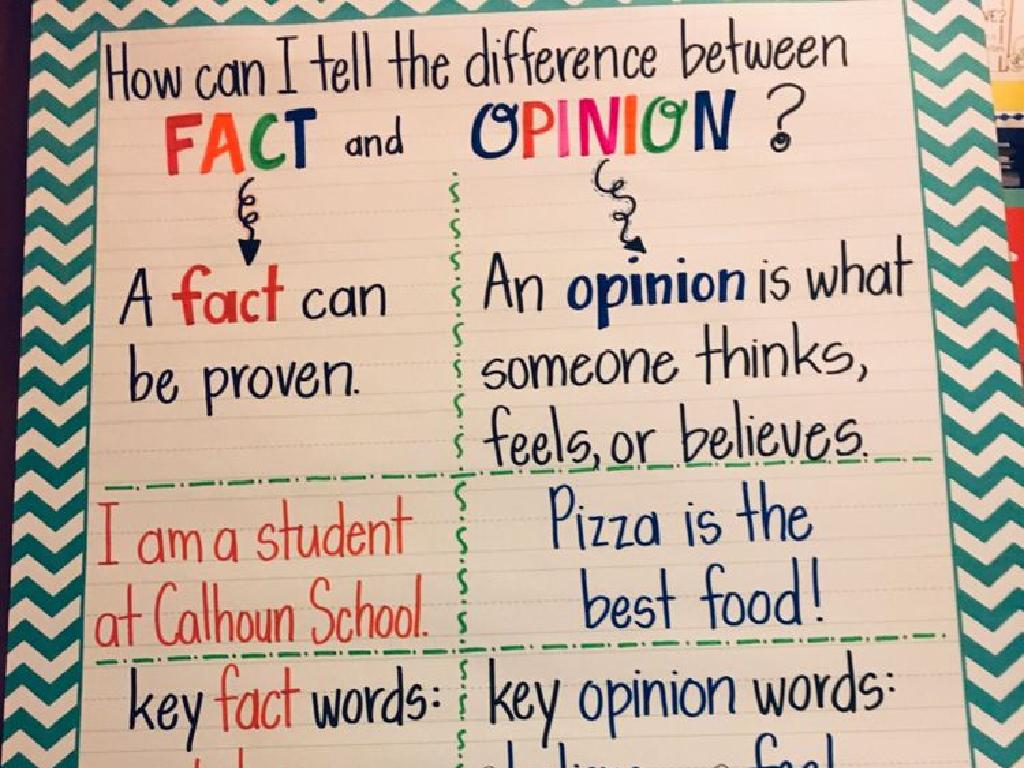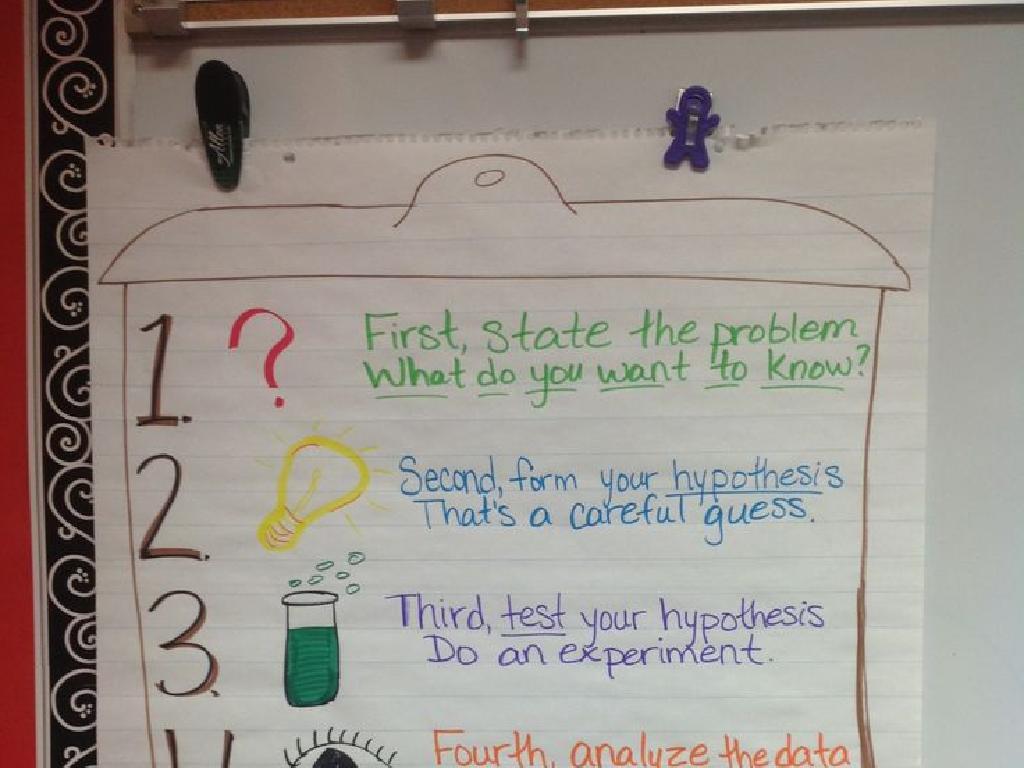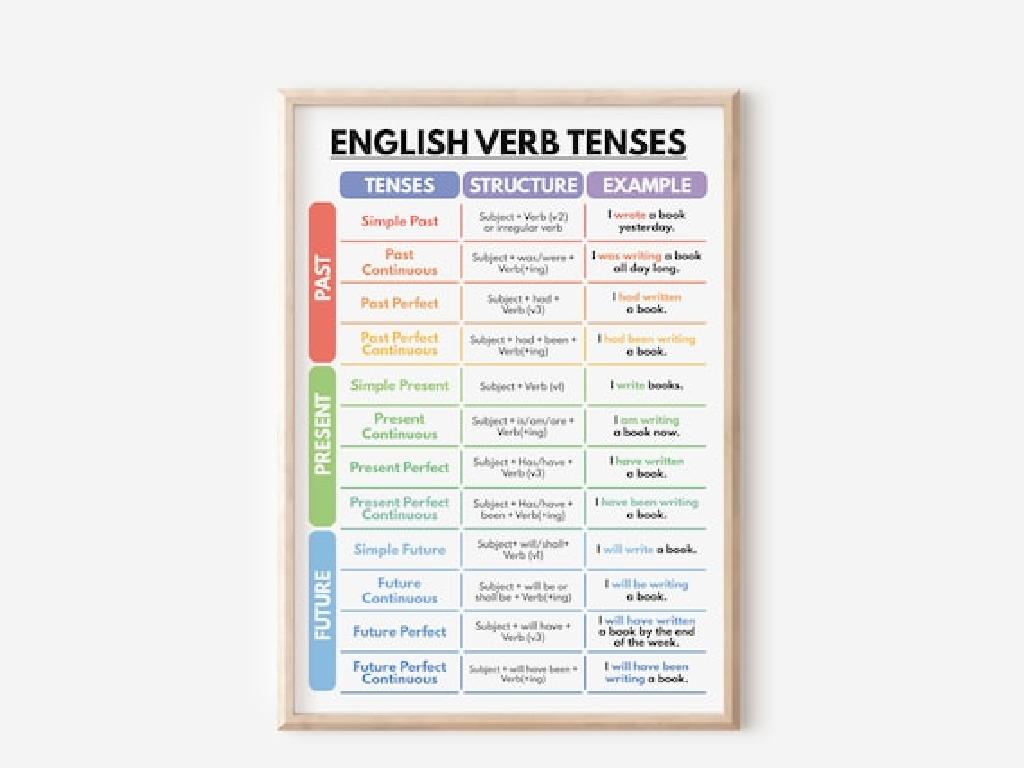Identify Plurals, Singular Possessives, And Plural Possessives
Subject: Language arts
Grade: Third grade
Topic: Nouns
Please LOG IN to download the presentation. Access is available to registered users only.
View More Content
Exploring Nouns: Plurals and Possessives
– What are nouns?
– A noun is a person, place, thing, or idea.
– Singular vs. Plural nouns
– Singular noun: one item, Plural noun: more than one item.
– What are possessives?
– Possessives show ownership or belonging.
– Singular vs. Plural possessives
– Singular possessive: adds ‘s, Plural possessive: adds ‘ after s
|
This slide introduces the basic concepts of nouns, their singular and plural forms, and possessive cases. Start by defining a noun and giving examples that the students can relate to. Explain the difference between singular and plural nouns by showing how adding ‘s’ or changing the word can indicate more than one item. Introduce possessives as a way to show that something belongs to someone or something. Highlight the difference in forming singular possessives by adding ‘s (e.g., the girl’s book) and plural possessives by adding an apostrophe after the s (e.g., the girls’ books) if the plural noun already ends with an ‘s’. Use visual aids and examples to help students understand these concepts. Plan an activity where students can practice identifying and using these forms in sentences.
Singular and Plural Nouns
– What is a singular noun?
– A singular noun means just one item.
– What is a plural noun?
– A plural noun means two or more items.
– Making nouns plural
– Add ‘s’ or ‘es’ to most nouns to show more than one.
– Rules: ‘s’ or ‘es’ endings
|
This slide introduces the concept of singular and plural nouns to third-grade students. Begin by explaining that a singular noun represents one single item, such as ‘dog’, ‘car’, or ‘house’. Then, discuss that a plural noun represents more than one item, like ‘dogs’, ‘cars’, or ‘houses’. Teach the students the general rule for making nouns plural by adding ‘s’ or ‘es’, depending on the ending of the word. For example, ‘cat’ becomes ‘cats’, and ‘bus’ becomes ‘buses’. Use visual aids or objects in the classroom to illustrate the difference between singular and plural. Encourage students to come up with their own examples and write them down. This will help solidify their understanding of how to identify and form plural nouns.
Making Nouns Plural
– Change ‘y’ to ‘i’ and add ‘es’
– For nouns ending in ‘y’ like ‘puppy’ becomes ‘puppies’
– ‘f’ or ‘fe’ endings change to ‘ves’
– Words like ‘leaf’ become ‘leaves’, ‘wife’ becomes ‘wives’
– Learn irregular plurals
– Some plurals are unique: ‘child’ to ‘children’, ‘mouse’ to ‘mice’
– Practice with examples
|
This slide introduces students to the rules for making nouns plural. Start by explaining that most nouns add ‘s’ to become plural, but there are special rules for words ending in ‘y’ and ‘f/fe’. Use examples like ‘puppy’ to ‘puppies’ and ‘leaf’ to ‘leaves’ to illustrate the changes. Highlight irregular plurals, which don’t follow standard rules, such as ‘child’ to ‘children’ and ‘mouse’ to ‘mice’. Encourage students to come up with their own examples and write them down for practice. This will help them understand and remember the different ways to make nouns plural.
Singular Possessive Nouns
– Show ownership with possessives
– Tells us who owns something
– Add apostrophe + ‘s’ to singular nouns
– Like in ‘dog’s bone’ – the bone belongs to the dog
– Example: The girl’s book
– ‘girl’s book’ means the book belongs to the girl
|
This slide introduces the concept of singular possessive nouns to third-grade students. It’s important to explain that possessive nouns show ownership or that something belongs to someone or something. For singular nouns, we add an apostrophe followed by the letter ‘s’ to create the possessive form. Use clear examples like ‘The girl’s book’ to illustrate that the book belongs to the girl. Encourage students to practice by identifying objects in the classroom and forming singular possessive nouns. For instance, ‘the teacher’s desk,’ ‘the student’s pencil,’ or ‘the cat’s toy.’ This will help them understand how to use apostrophes to show possession in writing.
Plural Possessive Nouns
– Show ownership by a group
– Like the toys of the kids = kids toys
– Add apostrophe to plural nouns ending in ‘s’
– Dogs’ collars, not dogs s collars
– Example: The teachers’ lounge
– Where teachers relax and eat
|
This slide introduces the concept of plural possessive nouns to third-grade students. It’s important to explain that these nouns show that something belongs to more than one person or thing. For most plural nouns that already end in ‘s’, adding an apostrophe after the ‘s’ makes them possessive. Provide clear examples, such as ‘the teachers’ lounge,’ which refers to a lounge that belongs to multiple teachers. Encourage students to think of items that belong to a group they are part of, like ‘students’ desks’ in the classroom. This will help them relate the concept to their everyday experiences.
Practice Time: Nouns Everywhere!
– Spot nouns in the classroom
– Singular to plural noun transformation
– Add ‘s’ or ‘es’ to make most nouns plural
– Forming singular possessives
– Add an apostrophe + ‘s’ to show ownership
– Creating plural possessives
– For plural nouns ending in ‘s’, just add an apostrophe
|
This slide is for a classroom activity where students will practice identifying nouns in their immediate environment, understanding the difference between singular and plural nouns, and learning how to form possessive nouns. Start by asking students to look around the classroom and list items they see. Then, guide them to change these nouns from singular to plural form, and finally to make them possessive. For example, ‘desk’ becomes ‘desks’ in plural, and ‘desk’s’ when showing possession in singular form, and ‘desks” for plural possessive. Encourage students to come up with their own examples and correct each other in a fun, interactive session. This activity will help solidify their understanding of nouns and their different forms.
Class Activity: Exploring Nouns and Possession
– Find objects around the classroom
– Write singular and plural forms
– Show possession with sentences
– Use ‘s to show possession, like ‘The desk’s color is brown.’
– Share your findings with the class
|
This activity is designed to help students understand the concept of singular and plural nouns as well as singular possessive and plural possessive forms. Have the students look around the classroom and pick out several objects. Then, they should write down the singular and plural forms of each noun they have chosen. Next, instruct them to write sentences showing possession, such as ‘The book’s cover is blue’ for singular possessive and ‘The books’ covers are colorful’ for plural possessive. Encourage creativity and ensure they understand the use of apostrophes in showing possession. After completing the task, students will share their sentences with the class, which will reinforce their learning and provide an opportunity for peer learning.
Nouns Recap & Looking Ahead
– Review: Singular & Plural Nouns
– Singular nouns name one item, plural nouns name more than one.
– Review: Singular & Plural Possessives
– ‘Cat’s toy’ shows one cat owns a toy, ‘Cats’ toys’ shows many cats own toys.
– Importance of Understanding Nouns
– Knowing nouns helps in writing and speaking clearly.
– Next Class: Compound Nouns
|
As we wrap up today’s lesson, remember that singular nouns refer to one thing, while plural nouns refer to more than one. Singular possessive nouns show ownership by one, and plural possessive nouns show ownership by more than one. Understanding these concepts is crucial for clear communication. For homework, students should find examples of singular, plural, and possessive nouns in their favorite books. Next class, we’ll explore compound nouns, which combine two words to create a new meaning. Encourage students to think of examples of compound nouns they already know, like ‘basketball’ or ‘toothbrush’, to prepare for our next lesson.






